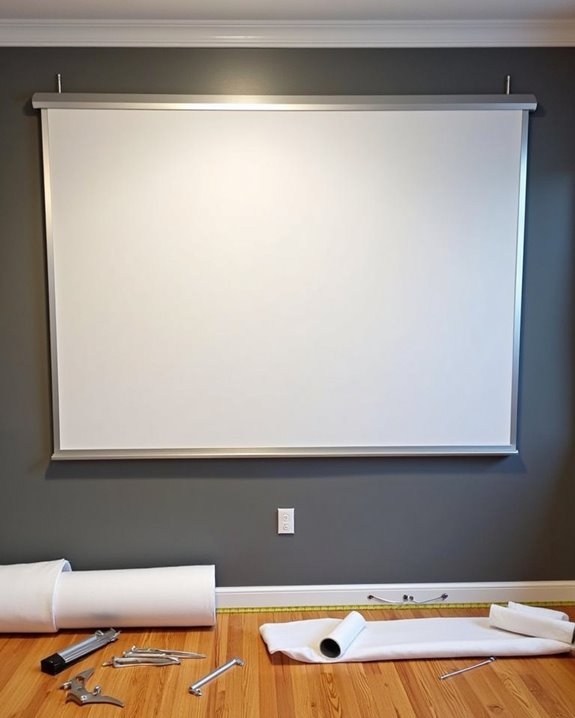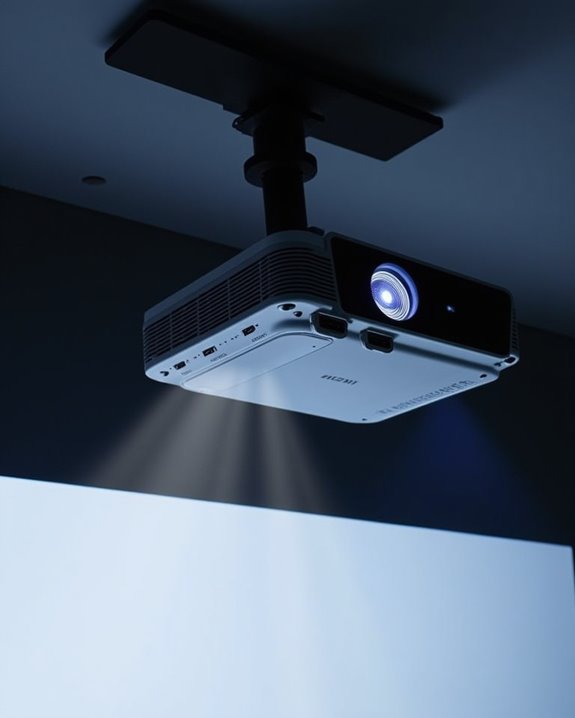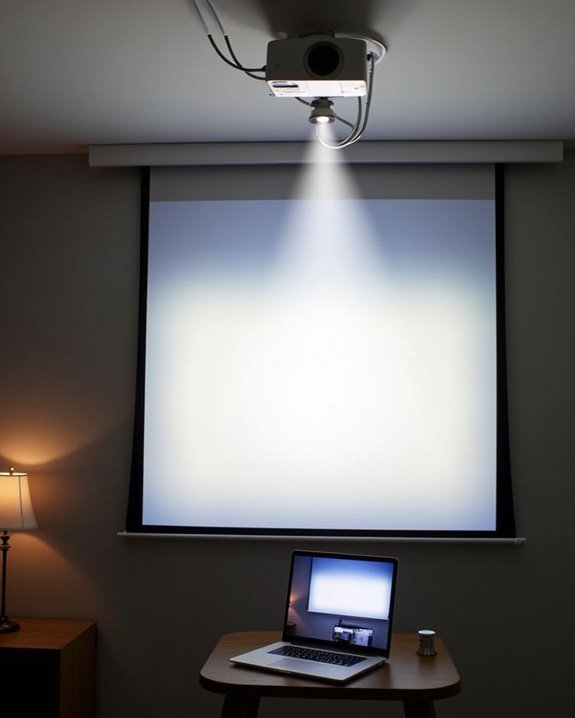If you’re looking to transform your home entertainment setup, a projector offers a compelling alternative to traditional TVs. You’ll find options ranging from pocket-friendly $50 models to premium $12,000 professional systems, each serving distinct needs and environments. Your budget, space requirements, and intended use will determine which category makes sense for your situation. Understanding the real costs involved, including essential accessories like screens and audio systems, helps prevent unexpected expenses when making this significant technological investment.
Key Takeaways
- Budget projectors range from $50-$300, while home theater models cost $1,200-$12,000 depending on features and image quality.
- Projectors offering 100-inch screens cost around $1,000, significantly cheaper than equivalent large TVs priced at $25,000+.
- Resolution, technology type (laser, LED, lamp), and connectivity options directly influence projector pricing.
- Budget for accessories including screens ($128+), sound systems ($40-$230), and mounting hardware when planning your purchase.
- The projector market is growing, with technological advancements like laser projection driving pricing trends upward.
Understanding Projector Price Ranges by Category
When you’re steering the world of projector technology, understanding the various price ranges can help you make an informed decision that matches your needs and budget. Projectors typically fall into five distinct categories, each offering different capabilities and features.
Budget-friendly options ($50-$200) provide basic functionality for casual viewing, while mid-range models ($200-$300) introduce better brightness and mobile connectivity options. Entry-level home theater projectors ($1,200-$1,800) deliver enhanced image quality and smart features like voice control. High-end models ($1,800-$2,700) offer advanced technologies such as ultra-short throw capabilities and superior gaming performance. For the ultimate experience, premium projectors ($2,700-$12,000) provide professional-grade performance with exceptional contrast ratios and color accuracy, suitable for dedicated home theaters or commercial applications. Many quality projectors under $500 now offer 3LCD technology, which ensures accurate, rainbow-free color reproduction for versatile use.
The True Cost Comparison: Projectors vs. Large TVs
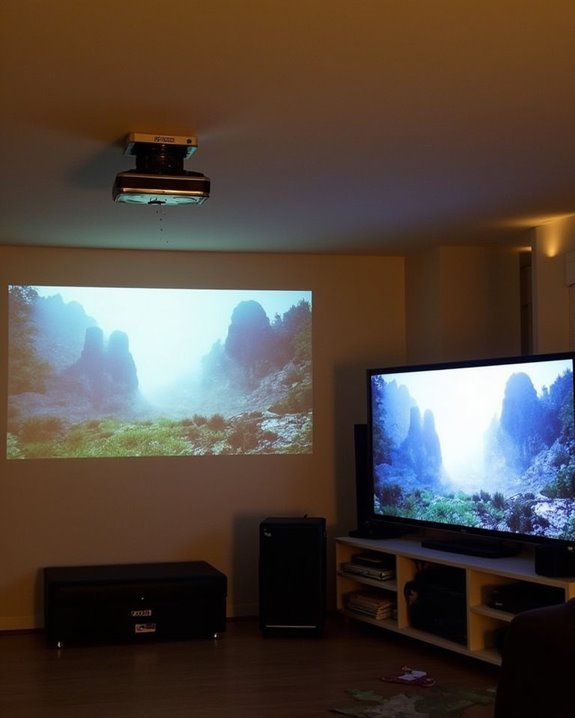
As you weigh your options for a home entertainment upgrade, comparing the true costs between projectors and large TVs reveals surprising insights about value. When looking at screens over 100 inches, projectors consistently offer better financial value, with good models available around $1,000, comparable to a decent 75-inch TV. Meanwhile, ultra-large TVs like the 97-inch LG G4 cost nearly $25,000.
Your home theater setup costs extend beyond initial purchase price, however. Projectors require occasional lamp replacement and screen calibration, adding to long-term expenses. TVs generally demand less maintenance but limit your size options dramatically. For the truly immersive viewing experience, even premium projectors like the $14,999 JVC DLA-NZ800 remain more affordable than equivalent-sized televisions, making them the cost-effective choice for cinematic experiences. Additionally, many modern projectors include auto keystone correction, simplifying setup and improving image quality without extra equipment.
Key Features That Determine Projector Pricing
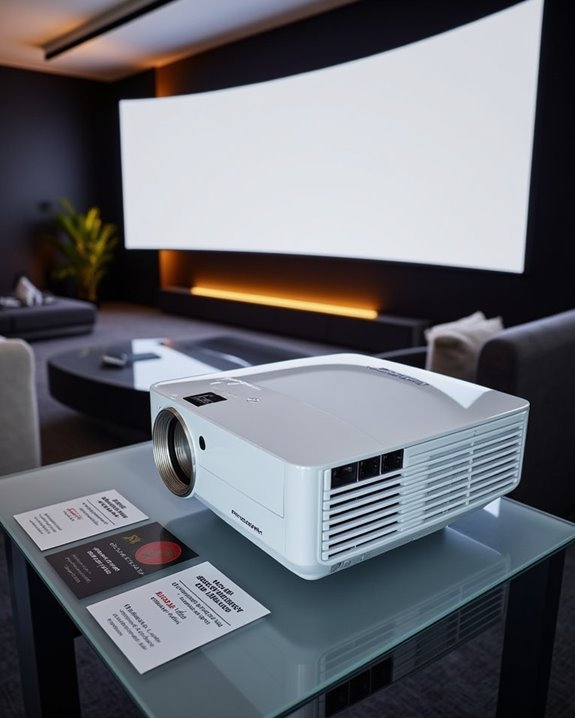
Understanding a projector’s price requires examining the key features that influence its cost. Screen resolution stands as a primary factor, with 4K models commanding markedly higher prices than Full HD alternatives due to their enhanced image clarity and pixel density. The projector’s core technology—whether LED, lamp-based, or laser—also substantially impacts pricing, with laser options offering superior brightness and longevity at premium price points.
Your connectivity options directly affect cost, as models featuring multiple HDMI ports, USB connections, and wireless capabilities typically demand higher prices. Additional factors include brightness (measured in lumens), which determines a projector’s effectiveness in well-lit environments, and special features like HDR support, keystoning capabilities, and built-in smart functions. Portability also influences pricing, with compact, lightweight models often costing more despite their smaller size. Moreover, advanced cooling systems that extend operational life and maintain performance are often found in higher-priced models, reflecting the importance of heat dissipation and cooling systems in modern projectors.
Budget Planning: Essential Accessories and Add-on Expenses
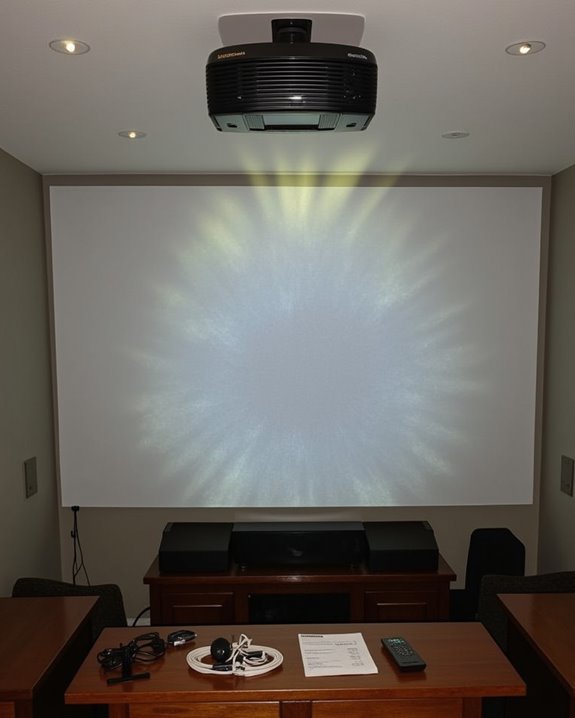
Purchasing your projector represents just one part of the total investment you’ll need to make for a complete viewing experience. Beyond the projector itself, you’ll need to budget for several essential accessories, including a quality screen ranging from $127.99 and up, with various screen sizes available to match your space.
Sound options considerably impact your setup costs, with basic soundbars starting around $40 while higher-quality options like Edifier R1850DB speakers run approximately $230. Additional necessities include mounting hardware, HDMI cables, and streaming devices such as the Fire TV Stick 4K ($39.99). For ideal performance, consider allocating funds for maintenance supplies, extension cables, and room modifications like thick curtains or soundproofing materials. Planning for these accessories upfront will help you develop a realistic budget for your entire projector system.
2025 Market Trends Affecting Projector Values
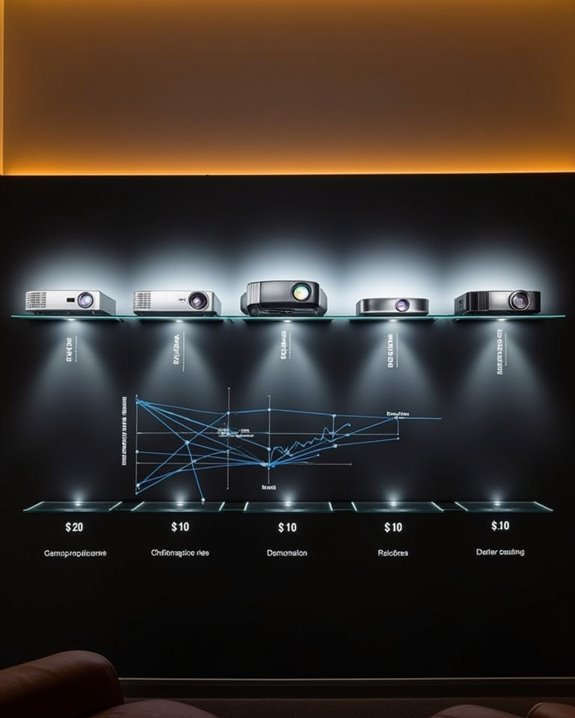
When you’re evaluating projector investments, the global market trends substantially influence both pricing and value propositions across all segments. The market’s impressive growth trajectory, from $11.1 billion in 2024 to a projected $14.53 billion by 2029, reflects increasing demand across multiple industries.
Laser projection technology advancements are driving premium pricing tiers, with manufacturers emphasizing longer lifespans and superior image quality to justify higher costs. Regional market trends vary considerably, with North America growing more slowly at 2.5% CAGR compared to emerging Asian markets. The interactive projector segment shows exceptional momentum, expected to grow from $3,965.6 million to $11,526.5 million by 2035, indicating strong professional market demand. Additionally, 3D projector values continue rising, with this segment projected to nearly double to $9.44 billion by 2034.
Frequently Asked Questions
How Long Do Projector Bulbs Typically Last Before Needing Replacement?
Your lamp lifespan depends on the technology: traditional bulbs last 1,500-5,000 hours, while LED lasts 20,000-60,000 hours, and laser extends to 50,000+ hours. You’ll know it’s time for bulb replacement when brightness diminishes.
Can Projectors Work Effectively in Bright, Well-Lit Rooms?
Yes, you’ll need projectors with 3,000+ lumens for effective screen brightness in bright rooms. Consider laser models and manage ambient light with curtains or high-gain screens for the best viewing experience.
What’s the Ideal Room Size for Different Projector Types?
While you might think any projector works anywhere, it’s not true. Your ideal room size depends on screen size: small (30-60″) for personal spaces, medium (80-120″) for living rooms, and large (150+”) for theaters. Control room lighting accordingly.
Do Projectors Consume More Electricity Than Comparably-Sized TVS?
Yes, most projectors consume more electricity than comparably-sized TVs. You’ll notice higher power consumption with high-end models, though some LED projectors offer better energy efficiency, especially when using eco-mode settings.
Are Projectors Suitable for Gaming With Low Input Lag?
Like a formula one racer, modern DLP projectors blast through gaming latency concerns. You’ll find many models offering under 20ms lag, especially when you’re running at 1080p/120Hz display resolution with fast mode enabled.


